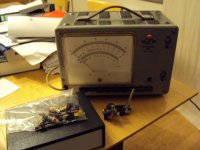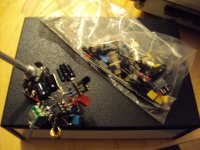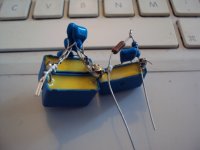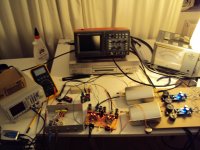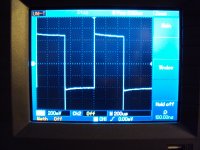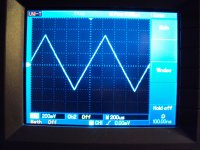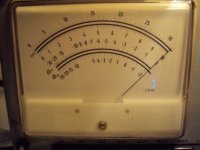Lme49990
Joachim, here is another candidate for lowest noise & lowest THD: the LME49990.
THD < 0.00002 at 20kHz, PSRR > 100dB at 20kHz.
Blows your mind.
http://www.national.com/ds/LM/LME49990.pdf
jd
Joachim, here is another candidate for lowest noise & lowest THD: the LME49990.
THD < 0.00002 at 20kHz, PSRR > 100dB at 20kHz.
Blows your mind.
http://www.national.com/ds/LM/LME49990.pdf
jd
I have seen that. PSSR is amasing. When you think you have found a good OP amp another is showing up quite soon recently.
Athough National fired a lot of famous designers recently there seems to be an infinite number of substitutes on the free market.
Athough National fired a lot of famous designers recently there seems to be an infinite number of substitutes on the free market.
Lme49990
Hi Joachim, Jan,
I'm gonna order a few LME49990 and make a nice little amp with them and will post my result when ready.
Thanks for the info!
Best regards,
Audiofanatic 😉
Hi Joachim, Jan,
I'm gonna order a few LME49990 and make a nice little amp with them and will post my result when ready.
Thanks for the info!
Best regards,
Audiofanatic 😉
Thats fine. They come quicker then i can purchase them, not to mention build anything.
We could organise a shoutout at Jan. AD against National.
Anyway, the way i use the AD makes distotion so low ( shunt feedback) that audible differences will be very small. I have not studied the National enough if it can drive a feedback resistor lower then 600 Ohm. In that case, using the Phonoclone topology you have to burn a lt of amplification in a resistive devider.
We could organise a shoutout at Jan. AD against National.
Anyway, the way i use the AD makes distotion so low ( shunt feedback) that audible differences will be very small. I have not studied the National enough if it can drive a feedback resistor lower then 600 Ohm. In that case, using the Phonoclone topology you have to burn a lt of amplification in a resistive devider.
You would need super exact capacitors and resistors so to have any tight tolerance curve check meaning. Tough without a lab grade calibrated bridge to select. It can simply compound with de-emphasis tolerances and even out or boost a curve trend erratically, If it does not have seriously better selected components than what it feeds. Maybe it will be practical to tune it against a text book Riaa emphasis curve graphically on the FFT than to be sure about parts values. Just an idea.
Usually i work with a mathematically generated curve in my DAAS analyser.
This is not awailable at the moment out of known resons.
I selected the parts by using 0.01% reference resistors and 0.1% reference caps.
My bridge shows values that are 99.9 kOhm for a 100kOhm resistor and 9.9nF for a 10nF cap. I interpolated the values and trimmed with 1% silver mica. That is the best i can do at home. Lets see what happens because the mathematics of the Self RIAA are indisputable.
I am planning on an aditinal balanced input for The JG Self.
The topolohy is an inamp made from Op amps.
I made the resistor values as low as i could to avoid noise. The LME49990 can drive 20mA clean so with the choosen values i get 3V max output. That is ample for a Pre-Pre.
Noise should be around 1.4nV / qHz
This is not awailable at the moment out of known resons.
I selected the parts by using 0.01% reference resistors and 0.1% reference caps.
My bridge shows values that are 99.9 kOhm for a 100kOhm resistor and 9.9nF for a 10nF cap. I interpolated the values and trimmed with 1% silver mica. That is the best i can do at home. Lets see what happens because the mathematics of the Self RIAA are indisputable.
I am planning on an aditinal balanced input for The JG Self.
The topolohy is an inamp made from Op amps.
I made the resistor values as low as i could to avoid noise. The LME49990 can drive 20mA clean so with the choosen values i get 3V max output. That is ample for a Pre-Pre.
Noise should be around 1.4nV / qHz
Attachments
Hi Joachim, Jan,
I'm gonna order a few LME49990 and make a nice little amp with them and will post my result when ready.
Thanks for the info!
Best regards,
Audiofanatic 😉
José, I don't think they have samples available yet.
jd
Samples
Hi Jan,
I've ordered a few samples yesterday and will have them within a few day's!
So If you want to try them out, just log in and order them asap.
These OPAmp's looks Goooooooood 😛
Gr,
Audiofanatic 😉
José, I don't think they have samples available yet.
jd
Hi Jan,
I've ordered a few samples yesterday and will have them within a few day's!
So If you want to try them out, just log in and order them asap.
These OPAmp's looks Goooooooood 😛
Gr,
Audiofanatic 😉
I have not posted for a while because i was very bussy building the RIAA Encoder and make it work reliably and precise. That was bigger of a task that this seemingly simple circuit sugests. Finding precise resistors and caps was not easy. I have no problem measuring them to better precission then 0.5% but i got a bit fanatic and had to drive into town many times to buy some and get some from a friend. It is now a wild combination of Wima FKP1, Silver Mica, Dale RS55 and normal 1% metalfilm that i selected out of my waiste bin.
Then i ran into trouble with the servo and then the second amplification stage did not work. The mistake was so ambarassing stupid that i spare you the details. I looked several hours into the box and could not find it. Let me say so much that building this out of double OPamps was not a good idea. After i got it working i found that measuring at that low level over such a wide bandwidth is a challange in itself.
Some hours ago i got it finally working and have first results.
I measured the High Z MPP with Inductive RIAA and in the audible band i found very similar results then what i had measured over the DAAS. The DAAS limits measurements to 20kHz and one of the advantages of this encoder is that i can measure over a much wider high frequency bandwidth.
One very telling test is a 1kHz or even 10kHz quarewave. In an ideal situation the combination of Encoder and RIAA gives a perfectly quare quarewave.
What i found with the Inductive RIAA is a 7dB overshot at over 400kHz. If that is the result of the Encoder or the Inductive RIAA itself i will find out tomorrow.
For other purposes i had build a little wideband linear measurement amp from an OPA627 that should be very flat to over 10Mhz. With that amp and my Sennheiser Tube
Voltmeter i will test the setup.
My next post shows some pictures i collected over the last hours.
Then i ran into trouble with the servo and then the second amplification stage did not work. The mistake was so ambarassing stupid that i spare you the details. I looked several hours into the box and could not find it. Let me say so much that building this out of double OPamps was not a good idea. After i got it working i found that measuring at that low level over such a wide bandwidth is a challange in itself.
Some hours ago i got it finally working and have first results.
I measured the High Z MPP with Inductive RIAA and in the audible band i found very similar results then what i had measured over the DAAS. The DAAS limits measurements to 20kHz and one of the advantages of this encoder is that i can measure over a much wider high frequency bandwidth.
One very telling test is a 1kHz or even 10kHz quarewave. In an ideal situation the combination of Encoder and RIAA gives a perfectly quare quarewave.
What i found with the Inductive RIAA is a 7dB overshot at over 400kHz. If that is the result of the Encoder or the Inductive RIAA itself i will find out tomorrow.
For other purposes i had build a little wideband linear measurement amp from an OPA627 that should be very flat to over 10Mhz. With that amp and my Sennheiser Tube
Voltmeter i will test the setup.
My next post shows some pictures i collected over the last hours.
Here some pictures. First the measurement setup.
From left : DSD generator, RIAA Encoder in small metall box. 40MHz Digital Scope,
Sennheiser Tube True RMS Meter ( bandwidth 1MHz)
1kHz Quarewave over Encoder, High Z Mpp - Inductive RIAA
1kHz Triangle .... same...
From left : DSD generator, RIAA Encoder in small metall box. 40MHz Digital Scope,
Sennheiser Tube True RMS Meter ( bandwidth 1MHz)
1kHz Quarewave over Encoder, High Z Mpp - Inductive RIAA
1kHz Triangle .... same...
Attachments
Does it give you the same soft down tilt you got for your Riaa on the DAAS? What was it, something like 0.2dB 10kHz less than 1kHz.
P.S. Dedicated work, congrats. What is the model of your TFT DSO?
P.S. Dedicated work, congrats. What is the model of your TFT DSO?
I try one more time.
Left: Level at 200kHz
Right: Level at 1kHz
Well uploading does does not work. I try again tomorrow.
Thinking more about the ringing at 450kHz i think the reason is in the Encoder.
The opamp will reach its output swing at some point higher up and then a forth time constant is established.
I will look into that in more depth when i find the time.
Until 100kHz everything seems ok.
Left: Level at 200kHz
Right: Level at 1kHz
Well uploading does does not work. I try again tomorrow.
Thinking more about the ringing at 450kHz i think the reason is in the Encoder.
The opamp will reach its output swing at some point higher up and then a forth time constant is established.
I will look into that in more depth when i find the time.
Until 100kHz everything seems ok.
